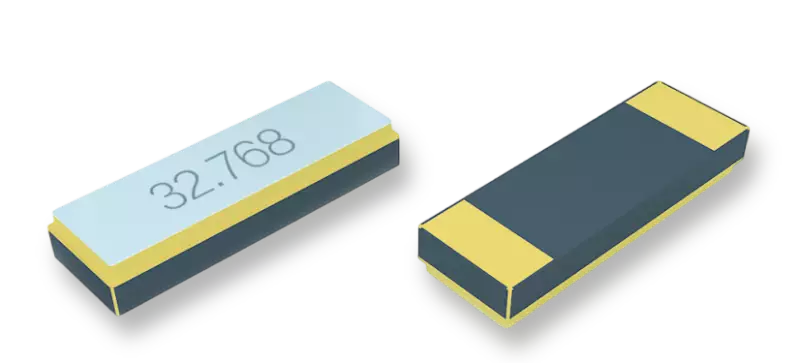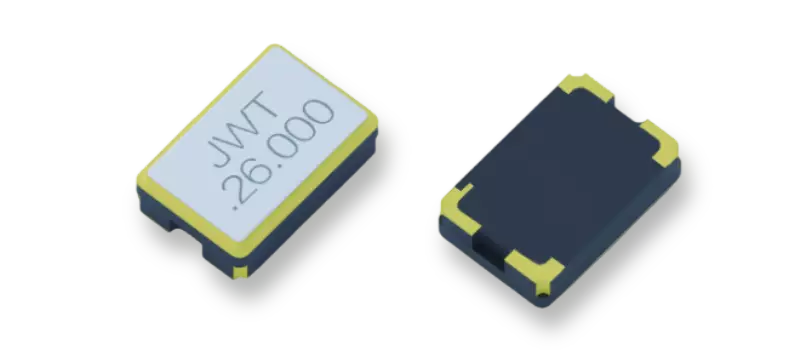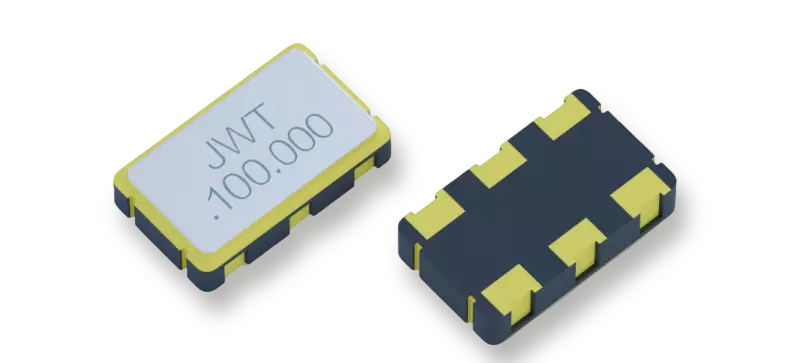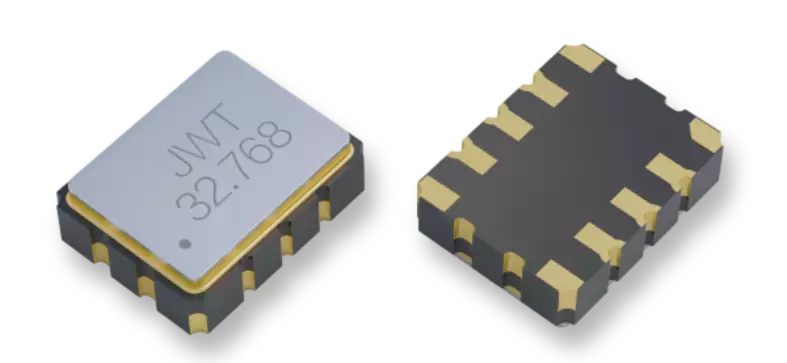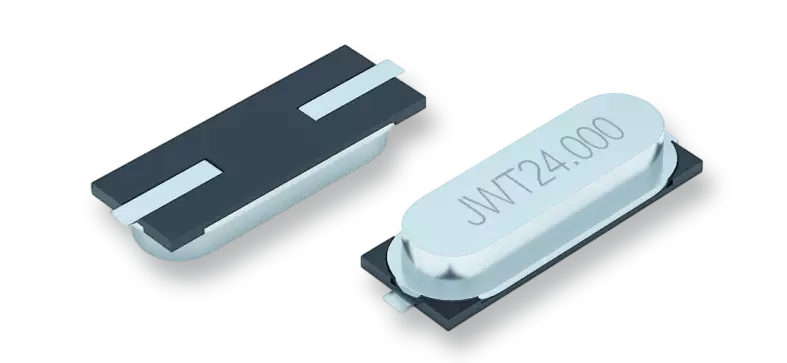Guide complet pour la sélection et l'application des oscillateurs à cristal
Date de sortie : 30 octobre 2025
oscillateurs à cristal Les oscillateurs à quartz sont des composants indispensables des appareils électroniques modernes. Ils fournissent des signaux de fréquence stables, essentiels à la synchronisation et au bon fonctionnement de divers systèmes, notamment de communication, de mesure, d'horlogerie et de contrôle. Que ce soit dans les téléphones portables, les ordinateurs, les communications par satellite ou des secteurs comme l'automatisation et l'électronique automobile, leur utilisation est primordiale.
Jing Wei Te vous permettra de comprendre en détail les oscillateurs à cristal, en abordant leur principe de fonctionnement, les critères de sélection et leurs applications dans divers domaines, afin de vous aider à choisir l'oscillateur à cristal adapté à vos différents besoins.
Table des matières
Principe de fonctionnement des oscillateurs à cristal
Les oscillateurs à quartz fonctionnent grâce à l'effet piézoélectrique des cristaux de quartz. Soumis à un champ électrique, le cristal se déforme et, inversement, lorsqu'il vibre mécaniquement, il génère un signal électrique. Les oscillateurs à quartz sont conçus pour faire vibrer le cristal à une fréquence spécifique, produisant ainsi un signal d'oscillation stable. Ce signal est ensuite amplifié et converti par des circuits électroniques pour fournir une fréquence précise, largement utilisée pour la synchronisation, l'horlogerie et la génération de signaux dans de nombreux secteurs industriels.
Critères de sélection des oscillateurs à cristal
Le choix du bon oscillateur à cristal est crucial. Voici les principaux critères de sélection :
1. Gamme de fréquences
Différentes applications requièrent différentes fréquences. Les oscillateurs à quartz couvrent généralement une gamme de fréquences allant de quelques dizaines de kilohertz à plusieurs centaines de mégahertz. Le choix de l'oscillateur doit se faire en fonction de la fréquence de fonctionnement du système. Les oscillateurs haute fréquence conviennent aux systèmes de communication haute fréquence, tandis que les oscillateurs basse fréquence sont utilisés dans les horloges et les systèmes de synchronisation.
2. Précision et stabilité de la fréquence
La précision et la stabilité de la fréquence sont des paramètres de performance essentiels pour les oscillateurs à cristal. La précision de fréquence désigne l'écart entre la fréquence de sortie de l'oscillateur et la fréquence cible, tandis que la stabilité indique la capacité du cristal à maintenir une fréquence stable dans le temps. Pour les applications exigeant une précision et une stabilité élevées, telles que les systèmes de navigation et de communication par satellite, il convient de choisir des oscillateurs à cristal présentant de faibles erreurs de fréquence et une grande stabilité en température.
3. Adaptabilité à la température et à l'environnement
La température influe considérablement sur les performances des oscillateurs à cristal. La plupart des oscillateurs à cristal fonctionnent correctement à température ambiante, mais dans des environnements extrêmes (tels que des températures élevées ou basses ou une forte humidité), il convient de choisir des oscillateurs à cristal compensés en température (TCXO) ou des oscillateurs à cristal à température contrôlée par four (OCXO) afin de garantir des performances fiables et stables.
4. Type d'emballage
L'emballage type d'oscillateur à cristal Cela dépend de l'application. Les types de boîtiers courants sont les composants montés en surface (CMS). Le boîtier CMS est adapté aux produits électroniques modernes qui nécessitent des conceptions compactes.
5. Consommation d'énergie
Dans les applications aux exigences strictes en matière de consommation d'énergie, telles que les appareils mobiles ou les objets connectés (IoT), il convient de privilégier les oscillateurs à quartz basse consommation. Ces oscillateurs intègrent généralement des circuits oscillants plus efficaces et des modes de fonctionnement optimisés.
Applications des oscillateurs à cristal
Les oscillateurs à cristal sont largement utilisés dans diverses industries. Voici quelques applications typiques :
1. Systèmes de communication
En communication sans fil, en radiodiffusion et en communication par satellite, les oscillateurs à quartz servent de sources de signaux et de générateurs d'horloge pour garantir la stabilité et l'efficacité du système. Par exemple, dans les stations de base, ils fournissent des fréquences précises permettant la synchronisation des fréquences sur plusieurs canaux de communication.
2. Systèmes d'horlogerie et de synchronisation
Une synchronisation temporelle précise est essentielle pour de nombreux appareils, et les oscillateurs à quartz sont largement utilisés dans les circuits d'horloge, les minuteries et divers systèmes de synchronisation. Ils fournissent la référence temporelle précise nécessaire aux ordinateurs, montres connectées, appareils électroménagers et autres appareils électroniques grand public.
3. Électronique automobile
Les oscillateurs à quartz sont utilisés en électronique automobile pour les systèmes de navigation GPS, les communications embarquées et les calculateurs de gestion moteur (ECU). Ils sont particulièrement importants dans les technologies de conduite autonome, où un contrôle précis de la fréquence garantit le bon fonctionnement des systèmes et le traitement efficace des données.
4. Automatisation et contrôle industriels
En automatisation industrielle, les oscillateurs à quartz sont utilisés dans les systèmes de contrôle pour la génération de signaux, l'acquisition et le traitement des données de capteurs. Leur grande stabilité et leur résistance aux interférences les rendent adaptés à un fonctionnement fiable et durable dans des environnements industriels complexes.
5. Dispositifs médicaux
Les dispositifs médicaux exigent une synchronisation extrêmement précise, et les oscillateurs à quartz sont largement utilisés dans les électrocardiographes (ECG), les tensiomètres, les appareils d'échographie, etc. Ils garantissent un contrôle précis du temps et de la fréquence dans ces appareils, assurant ainsi des résultats de diagnostic fiables.
Recommandations et considérations relatives à la sélection
- Choisissez en fonction des exigences de l'applicationPour les applications exigeant une haute précision, telles que les systèmes de navigation par satellite ou les appareils de communication, choisissez des oscillateurs à cristal offrant une précision de fréquence et une stabilité thermique élevées.
- Tenir compte des facteurs environnementauxLa température et l'humidité peuvent affecter les performances des oscillateurs à cristal. Pour les environnements aux conditions extrêmes, il est recommandé de choisir des oscillateurs à compensation de température ou à température contrôlée afin de garantir leur stabilité.
- Équilibre entre consommation d'énergie et taillePour les applications sensibles à la consommation d'énergie, comme les appareils mobiles ou les systèmes embarqués, choisissez des oscillateurs à cristal compacts et à faible consommation.
- Stabilité à long termePour les applications exigeant une haute précision et une grande stabilité, telles que les systèmes de mesure et les équipements de communication, privilégiez les OCXO ou d'autres oscillateurs à cristal à haute stabilité.
Conclusion
Les oscillateurs à quartz sont des composants essentiels des appareils électroniques, jouant un rôle crucial dans les performances et la stabilité des systèmes. Lors du choix d'un oscillateur à quartz, il convient de prendre en compte des facteurs tels que la plage de fréquences, la précision, la stabilité, l'adaptabilité à la température, le format et la consommation d'énergie. Grâce aux informations fournies dans ce guide, vous comprendrez mieux comment choisir l'oscillateur à quartz adapté à votre application. Un choix judicieux vous permettra d'améliorer les performances globales de vos produits et systèmes électroniques.



